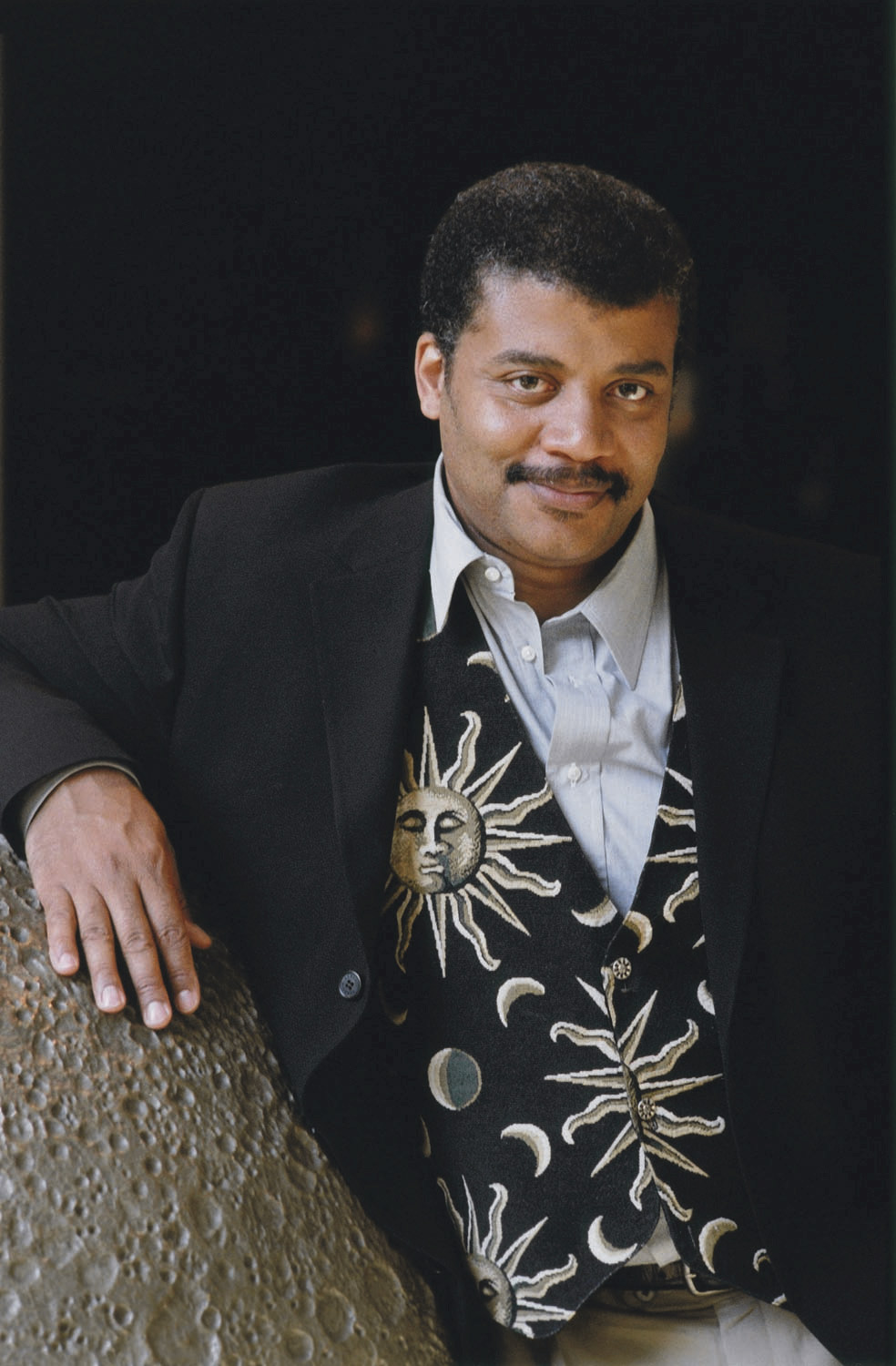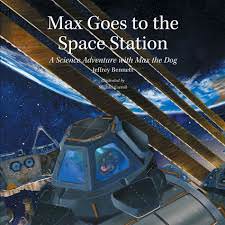It’s safe to say that the Polish astronomer Nicolaus Copernicus shook up the whole Universe. Well, our understanding of our place in the Universe. It was Copernicus who came up with the heliocentric model, placing the Sun at the center of the Solar System, with the Earth as just another planet.
Stunning Astrophoto: Moon in the Lighthouse
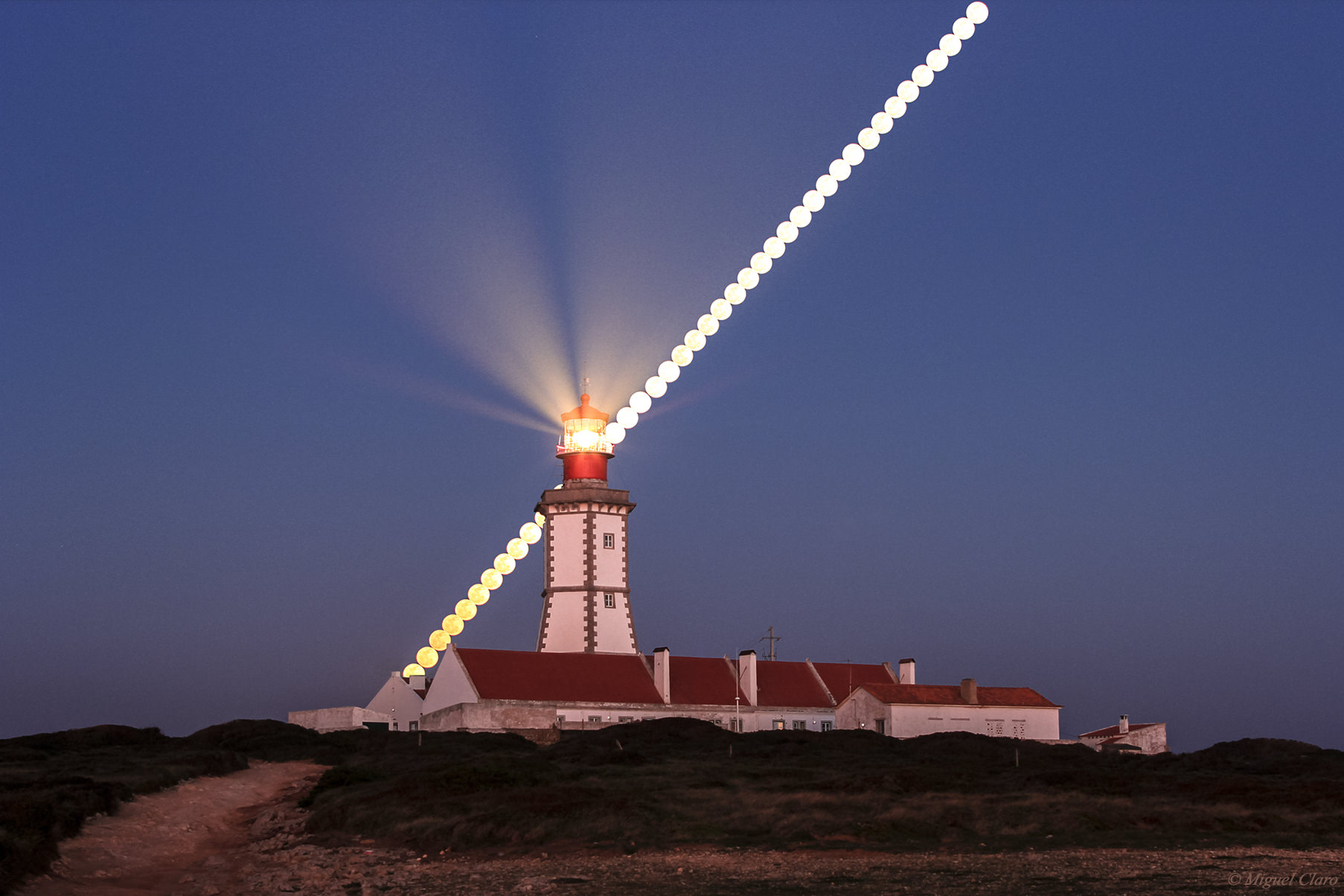
The March full Moon, sometimes called the “Worm Moon” for signaling the coming of spring in the northern hemisphere. This artistically stunning image taken by astrophotopher Miguel Claro is a sequence of 93 images taken at 2-minute intervals as the Moon traveled across the sky and past the Cape Espichel lighthouse near Sesimbra, Portugal. Miguel tells us that the lighthouse originally opened in 1790, and by 1865 it was powered by olive oil, changing to regular fuel in 1886, and much later by electricity by about 1926. The lighthouse measures 32 meters high and lies at an altitude of 168m above the see level. Presently, its luminous range is 20 nautical miles, about 38 km out to sea on a clear night.
Miguel used a Canon 60D – 35mm at f/4 ISO500; 1/5 sec. The sequence was taken on March 16, 2014 between 19:16 and 20:42.
Here’s a closeup:
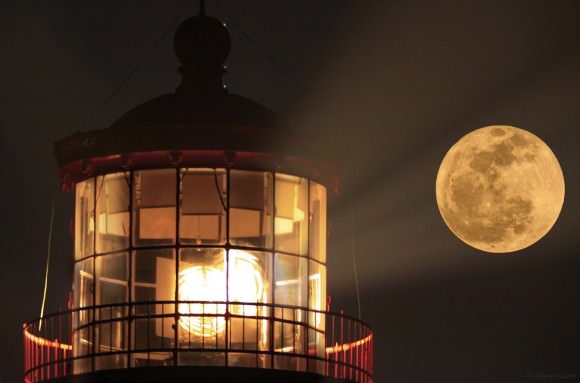
See more of Miguel’s work at his website.
You can check out other recent full Moon photos and more taken by our readers at our Flickr page.
Want to get your astrophoto featured on Universe Today? Join our Flickr group or send us your images by email (this means you’re giving us permission to post them). Please explain what’s in the picture, when you took it, the equipment you used, etc.
Watch Neil deGrasse Tyson Host ‘Selling Space’ Panel Tonight
Hot off of the popularity of the Cosmos reboot, host Neil deGrasse Tyson is going to host a panel at 7:30 p.m. EDT (11:30 p.m. UTC) tonight about “selling space.” Check it out in the livestream above. Here is the description from the American Museum of Natural History in New York City, which is hosting the event:
From serving NASA’s cargo needs to sending tourists on space vacations to mining asteroids for profit, aerospace engineers could transform space into our backyard. The sold-out 2014 Isaac Asimov Memorial Debate at the American Museum of Natural History will explore the idea of “selling space” with a panel of six entrepreneurs and space historians.
Besides Tyson (who is director of the museum’s Hayden Planetarium), here is who else is participating:
- Wanda M. Austin, President and CEO, The Aerospace Corportation
- Michael Gold, Director of DC Operations and Business Growth, Bigelow Aerospace
- John Logsdon, Professor Emeritus, Space Policy and International Affairs, George Washington University
- Elliot Pulham, Chief Executive Officer, Space Foundation
- Tom Shelley, President, Space Adventures, Ltd.
- Robert Walker, Executive Chairman, Wexler & Walker Public Policy Associates
There are no tickets left for the event, but you can watch it in the livestream above and interact with the hashtag #AsimovDebate.
For more information on Tyson, visit his website. The 13-part Cosmos series is airing every Sunday or Monday in many jurisdictions; check your local listings for more information.
How Does Life Recover from Mass Extinctions?
Every few dozen million years there’s a devastating event on Earth that kills nearly all the living creatures on our planet. Dr. Michael Habib explains how life always finds a way of recovering.
“Hello, my name is Michael Habib, and I’m an assistant professor of Cell and Neurobiology at the University of Southern California. I’m a biomechanist and paleontologist.”
How does life survive a mass extinction?
“One of the most amazing things about life on earth is that if you don’t kill EVERYTHING, it will eventually recover. Extinction is forever – if you kill a group, you’ll never have that group again, but what we find is that often the same ecologies show up again after a major extinction, because other groups end up diversifying to do the same things as groups we’d seen elsewhere.”
“So the world doesn’t end up looking entirely different after a mass extinction, although it would be quite different in a lot of ways. And even the great End Permian extinction killed about 99 percent of all species, or at least all the ones we can measure in the fossil record, and left that one percent, that’s all it takes to eventually recover.”
“Now, I imagine if you took a time machine to the first six months of the Triassic, it would be a very lonely, kinda ugly world. You’d notice that animals and plants were missing. The massive extinction affected all sorts of organisms.But, at the scales we’re looking at in the geologic record – tens of millions of years, a time span that’s pretty much unfathomable to human experience, you can eventually recover that diversity, with speciation event after speciation event kicks in and eventually creates a new diversity.”
“But after each mass extinction event, the world looks a bit different. You know, if I were to drop you in a time machine before the End Permian extinction, you’d notice a lot of things different about the world. You’d notice strange large mammal-like reptiles with large saber teeth running around as the large terrestrial organisms. You would see a few of the major groups of vertebrates that exist today, especially marine, but a lot of the terrestrial groups would be very different.”
“If I jump to after the End Permian extinction, enough that life had recovered, you’ll see those ancestors to dinosaurs, those terrasaurs, would show up in the mid to late Triassic. Then you start to see some plant groups that look more familiar to us, like plants that look a little bit more like modern conifers, things like that. So the world would definitely look different, but life does go on.”
Got Back Pain? This Suit Could Counteract Spine Problems In Space (And On Earth)
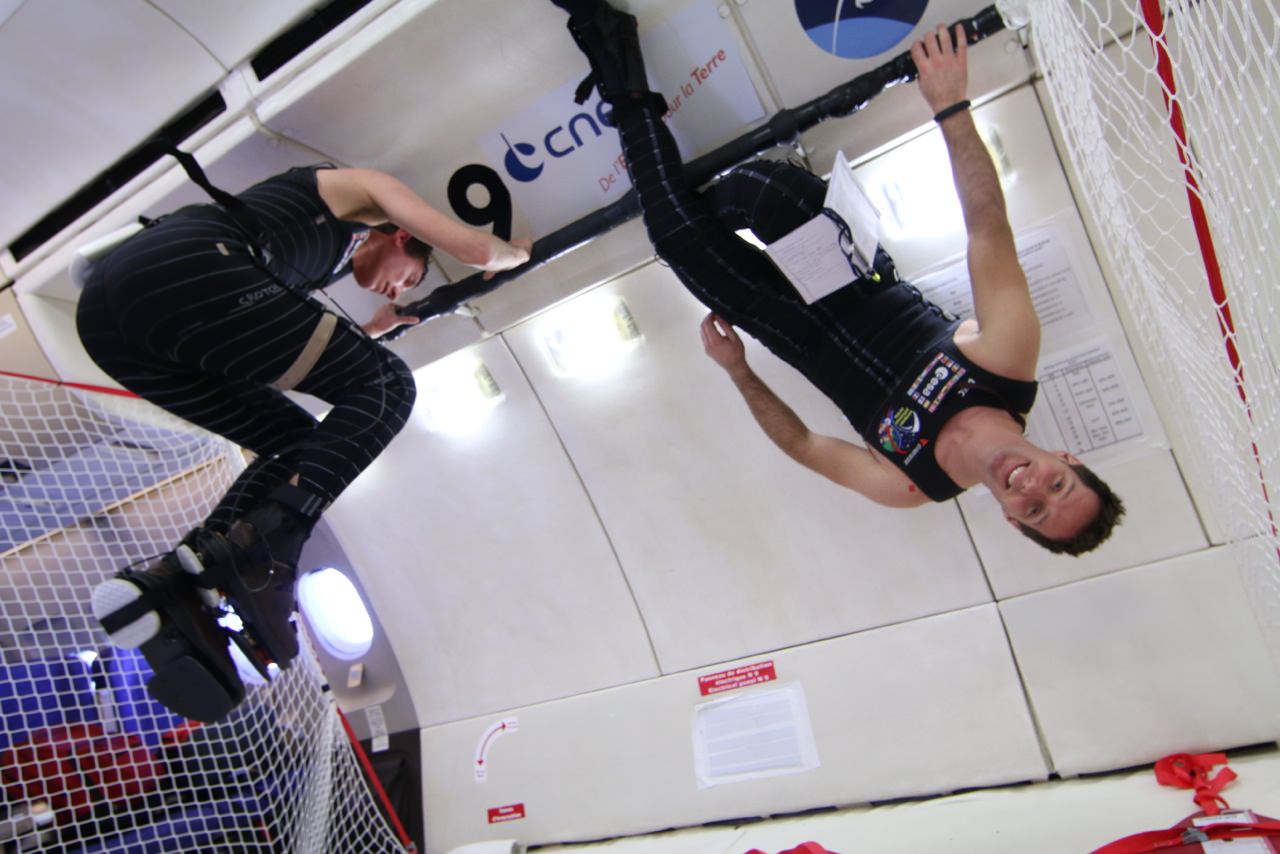
If you’ve ever felt insecure about your height, orbit is a great place to be. Astronaut spines lengthen up to 2.75 inches (7 centimeters) while they’re in microgravity. There are big downsides, however. First there’s the backache. Second, you’re four times as likely to get a slipped disc when you return to Earth.
The solution could be as simple as tight clothing. Above you can see French astronaut Thomas Pesquet (already flying high this week after he was publicly named to a flight in 2016) trying out a prototype of the skinsuit. Essentially, it’s so tight that it could prevent you from growing, which in turn would stop the pain and risk of damage.
“The skinsuit is a tailor-made overall with a bi-directional weave specially designed to counteract the lack of gravity by squeezing the body from the shoulders to the feet with a similar force to that felt on Earth. Current prototypes are made of spandex, although new materials are being examined,” the European Space Agency wrote.
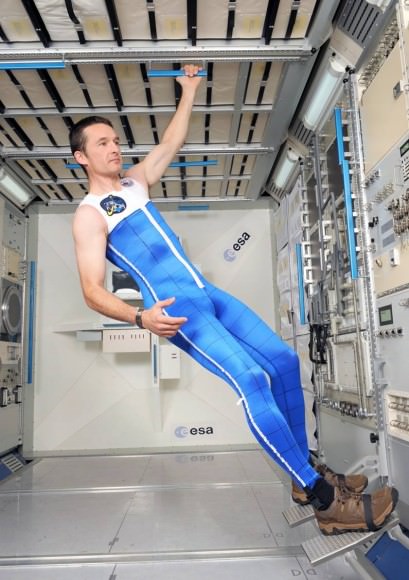
The first astronaut to test the suit out in space will be Andreas Mogensen, who will launch to the International Space Station next year.
ESA says if it works, the suit would not only be useful for astronauts, but also could be great for people with back pain on Earth — and possibly, even those with conditions such as cerebral palsy.
Prototypes are being developed between ESA’s Space Medicine Office, King’s College London (United Kingdom), University College London (United Kingdom) and the Massachusetts Institute of Technology (United States).
Clouds May Scotch Tomorrow’s Rare Erigone-Regulus Occultation
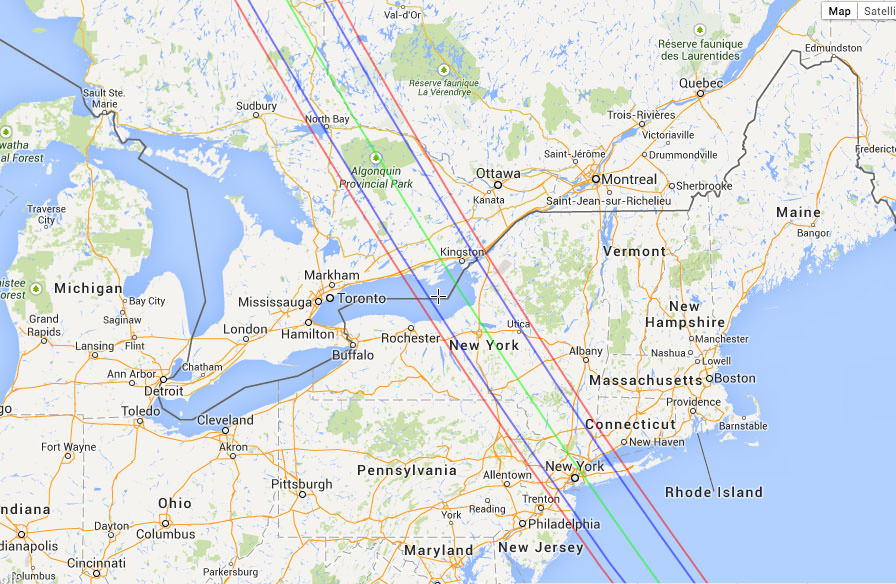
North America’s brightest predicted asteroid occultation may be one-upped by a much bigger occultation – a solid blanket of clouds. Asteroid 163 Erigone will cover or occult the bright star Regulus shortly after 2 a.m. Eastern Daylight Time tomorrow morning March 20. Observers along a 45-mile-wide (73-km) belt stretching from the wilderness of Nunavut to the salty seas of Bermuda could see the star vanish for up to 14 seconds. Provided they can find a hole in the clouds.
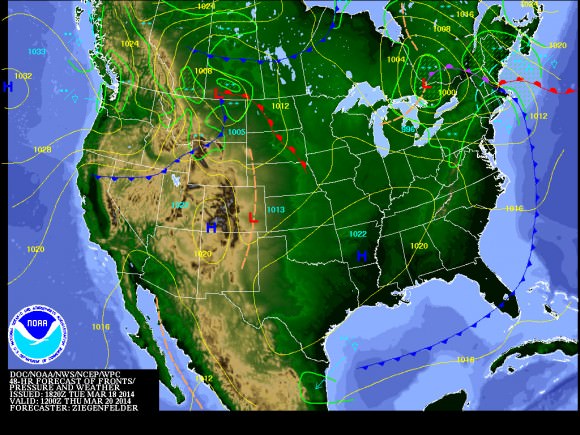
Overcast skies with a mix of rain or snow are predicted along virtually the entire track from the tiny berg of Cochrane in northern Ontario south through New York City, Connecticut and New Jersey. A sluggish cold front isn’t expected to clear skies until … no surprise here … after the event is over.
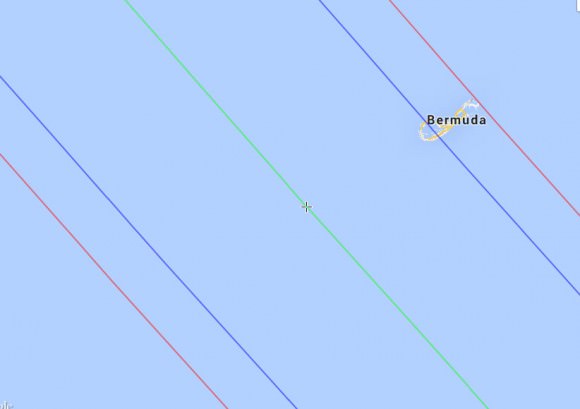
But there is one place where maybe, just maybe, the clouds may part to let Erigone do its job. Bermuda. The Bermuda Weather Service forecast calls for highs in the low 70s mid-week, but that balmy air may come packaged with a partly to mostly cloudy sky at the time of the occultation. A few determined observers are on their way there right now, hoping for better weather. In case the islands are socked in, some plan to rent planes to rise above the low-lying clouds typical this time of year and revel in the shadow of an asteroid. Even if clear, Bermuda lies near the eastern edge of the path. Any occultation there will be brief.
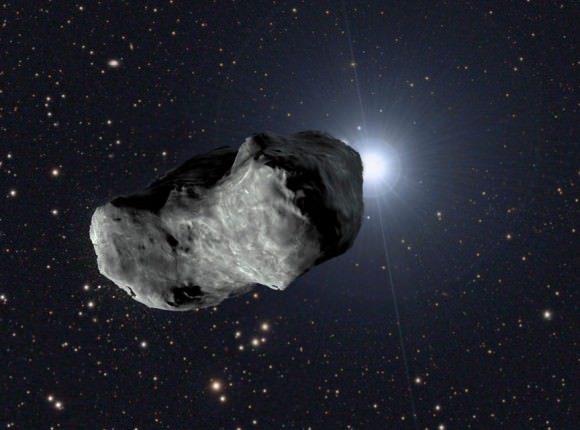
Yes, there will be more occultations, but bright ones that the public can enjoy with the naked eye are rare.
Skywatchers are nothing if not hopeful. We believe in the sucker hole, the name given to rogue clearings in an otherwise overcast sky. We are patient and steadfast when it comes to glimpsing the rarest of the rare. I know this because my friends and I have stood outside on winter mornings staring at the western sky, waiting for clouds to peel back that we might glimpse a Martian dust storm or new comet.
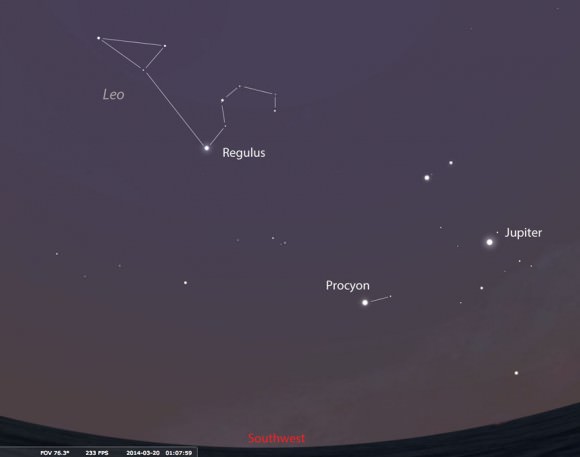
If there’s an astronomer’s credo, it’s this: “The sky might clear yet!” The latest weather word (9 a.m. March 19) for U.S. and Canadian observers indicates thinner clouds along the southern end of the track in New Jersey. Many of us considered driving to the event but changed our minds because of work, worries about weather and other commitments. Assuming the credo holds true, you’ll be able to watch Regulus disappear live from the comfort of your home thanks to the efforts of several observers planning to stream the event on the Web.
Here’s a list of streamers so far:
* Brad Timerson plans to go live with audio at 2 a.m. at a rest area along I-90 just west of Syracuse, NY.
* Ted Blank on UStream
* Steve Preston will broadcast an image of his camcorder screen
* Vagelis Tsamis will try to broadcast from Canada
* SLOOH
As always, everything depends on the weather. Let’s hope Mother Nature loses focus and lets a little clear sky slip by.
Why Flower Bouquets Regularly Show Up In NASA Mission Control
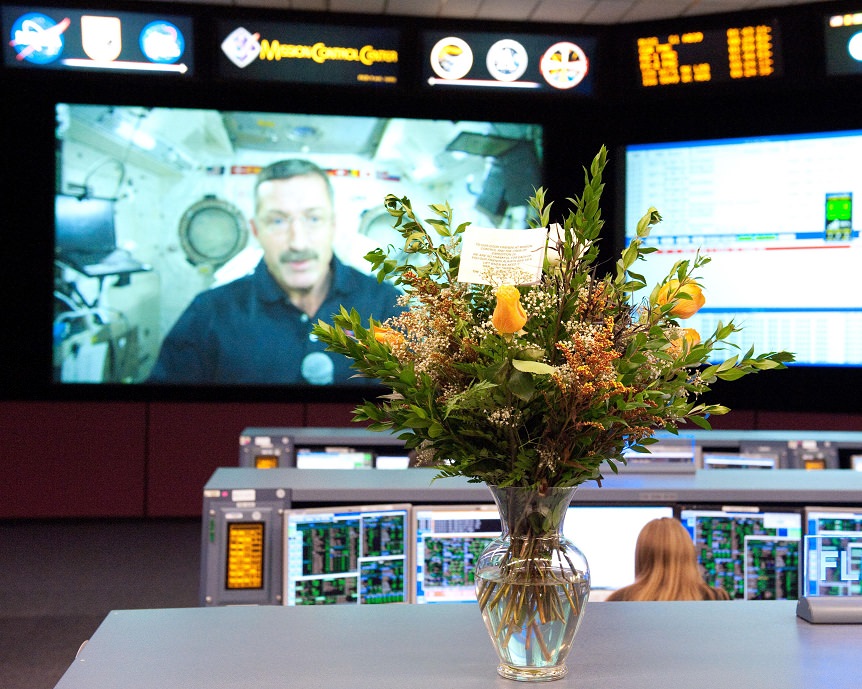
Three red roses and a white one. The flower bouquet sitting in NASA Mission Control right now in Houston is one of a series that has appeared with every single mission since 1988 — a small gift from a Texas family whose members are long-standing fans of space exploration.
The first bouquet showed up on landing day for the first flight (STS-26) after the shuttle Challenger explosion. And bouquets have continued for every flight since, a gift that NASA is glad to see when it arrives.
“It means a lot to the team here in Houston,” NASA spokesperson Josh Byerly said in the YouTube video above, an excerpt from a broadcast on NASA TV. “We’re big on tradition here at NASA, and we are very happy that this tradition continues.”
Each red rose symbolizes a member of an expedition crew — in this case, Expedition 39/40‘s Steve Swanson (NASA), Alexander Skvortsov (Roscosmos) and Oleg Artemyev (Roscosmos). The white one is a symbol of all of the astronauts who have lost their lives, such as those in the Apollo 1, Challenger and Columbia disasters.
Four years ago, when the 100th bouquet came to Mission Control, a flight director from STS-26 described what happened when he saw the flowers in 1988.
“When I first walked into the control room I noticed them right away, because it was so different, and I walked over and read the card,” stated Milt Heflin, who was a shuttle flight director at the time. “It was very simple, saying congratulations and wishing everyone the best on the mission. It was signed but it didn’t have any contact information for the senders.”
Helfin did manage to track down the family — Mark, Terry and daughter MacKenzie — and over the years, the Sheltons received cards of thanks and invitations to see launches and Mission Control.
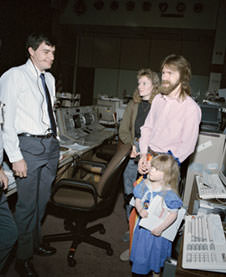
“I didn’t actually decide to do it until the day the STS-26 mission was to land, and I didn’t know that I even could get it done in time,” Mark Shelton stated, who added he first became interested in space after a childhood visit to the NASA Johnson Space Center in Houston in the 1960s.
“I called information to find a florist near the space center, and then I asked the florist if they could deliver roses to Mission Control. At first they said they couldn’t do it … but then they said they would try.”
The attempt succeeded, obviously, and with each mission new flowers arrive. The bouquets are now including participation from a “second” generation, Byerly said in the video, saying that they now come from the Sheltons and the Murphys.
6-Year-Old ‘Right Stuff’ Boy Reaches for the Stars with Petition Drive and Astronauts to Save NASA Funding
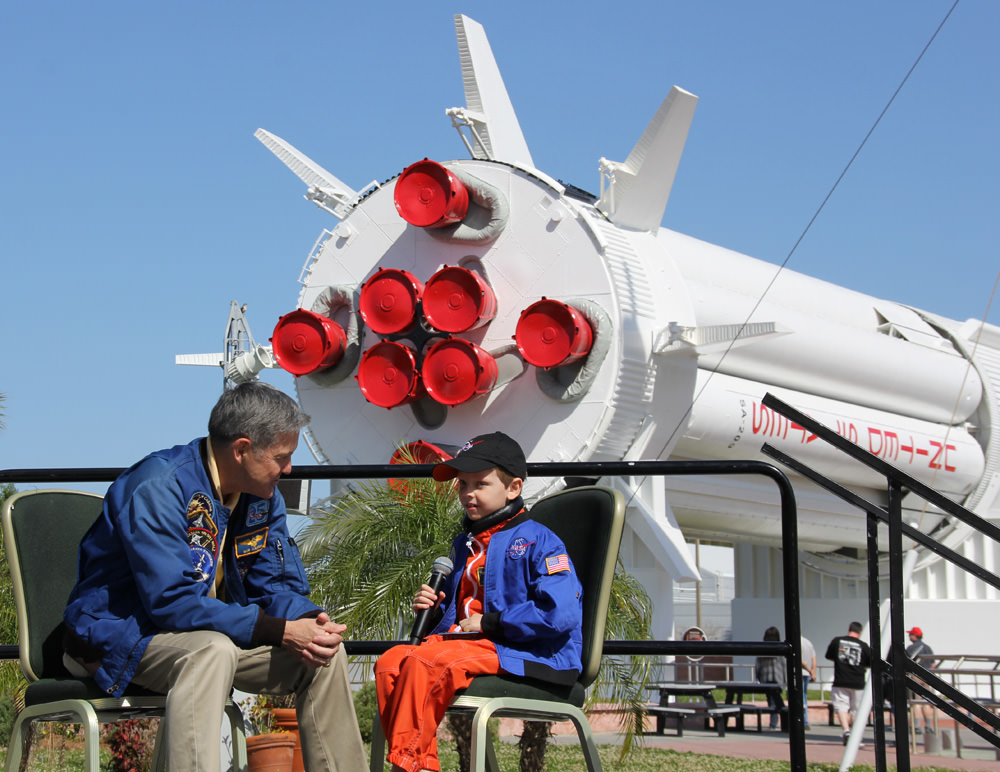
KENNEDY SPACE CENTER VISITOR COMPLEX, FL- When 6-year-old Connor Johnson from Denver, Colo. heard that his youthful dreams of going to Mars and ‘Reaching for the Stars’ were in danger due to funding cuts to NASA’s budget, he decided to do something about it.
So, with the encouragement of his parents, Connor started an online petition drive on the White House website in December 2013 to help save NASA’s budget and fulfill his dreams.
Connor’s petition drive efforts were noticed by a Denver TV station that broadcast a report on the young lads work that spurred his efforts.
Over 22,000 folks have already signed Connor’s petition.
That’s when the Kennedy Space Center Visitor Complex noticed his zeal in communicating the excitement and benefits of science and space voyages.
The KSC Visitor Complex invited Connor and to visit as a guest of honor with his family and to participate in the first ever ‘Robot Rocket Rally’ held this past weekend from March 14 to 16.
At a special ‘guest of honor’ ceremony held on Saturday, NASA recognized Connor’s unique contributions to space exploration with a public meeting at the Visitor Complex with Kennedy Space Center Director and space shuttle commander Bob Cabana.
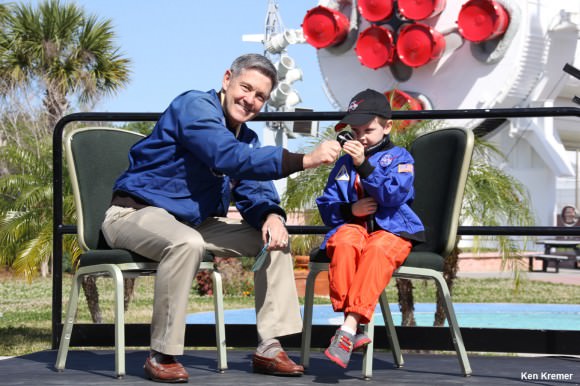
Cabana, who flew four shuttle missions, gave Connor several mementos, including a mission patch and an actual bolt from the International Space Station, as a token of appreciation from the agency.
“I think it’s great for Connor to be so interested in the future of NASA,” Kennedy Center Director Bob Cabana said.
“It shows great initiative on his part to do what he’s done.”
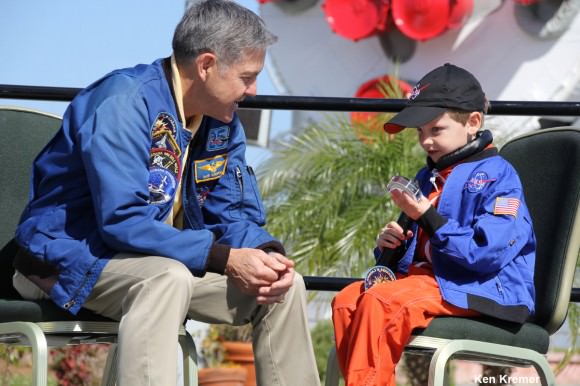
Credit: Ken Kremer – kenkremer.com
“Ultimately, the budget supports what we want to do with continuing International Space Station research and technology which will feed into SLS and Orion, leading to the asteroid initiative and on to Mars.”
“And it will dictate how we work with commercial partners to launch our astronauts from U.S. soil,” Cabana explained.
Millions of kids of all ages worldwide have been inspired by NASA for generations to pursue their dreams of science research and exploring space.
After the ceremony with Bob Cabana, the media including myself met with Connor.
I asked Connor when he became interested in space and where did he want to journey.
“I’ve been interested in NASA and space since I was three years old.”
“I want to be an astronaut and go to Mars!” Connor told Universe Today.
Since NASA currently plans to send the first manned mission to Mars in the 2030s, Connor is just about the right age.
Connor Johnson clearly exhibits the ‘Right Stuff.’
So much so that Apollo 17 Astronaut and Moon walker Eugene Cernan also spoke with Connor upon hearing of his work to save NASA’s funding.
What did Cernan say to Connor?
“Dream the unimaginable,” Moon walker Eugene Cernan said to 6-year old future Mars walker Connor Johnson.
During his visit to the Visitor Complex, Connor also visited with the Earth bound brother of NASA’s Robonaut 2 at the ‘Robot Rocket Rally’ and saw a demonstration of the robots new legs heading soon to the ISS on the SpaceX CRS-3 mission later this month. He and his younger brother also operated other robots at the festival.
Connor and his family spent the rest of the weekend touring the new Space Shuttle Atlantis pavillion, enjoyed Lunch With An Astronaut, featuring space shuttle astronaut Sam Durrance, and participated in the Astronaut Training Experience with space shuttle astronaut Mike McCulley.
What a thrilling way to begin a space career.
Way to go Connor!
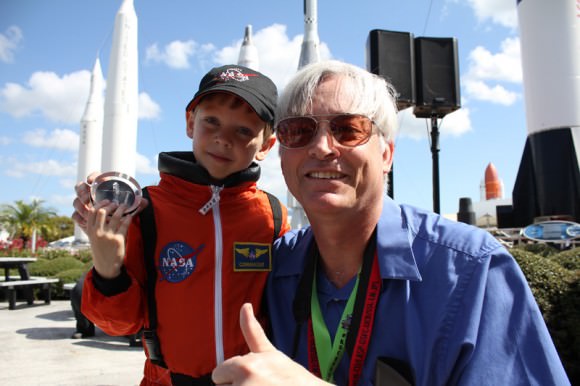
Stay tuned here for Ken’s continuing SpaceX, Orbital Sciences, commercial space, Orion, Chang’e-3, LADEE, Mars rover, MAVEN, MOM and more planetary and human spaceflight news.
Learn more at Ken’s upcoming presentations at the NEAF astro/space convention, NY on April 12/13 and at Washington Crossing State Park, NJ on April 6. Also evenings at the Quality Inn Kennedy Space Center, Titusville, FL, March 24/25 and March 29/30.
And watch for Ken’s SpaceX launch coverage at Cape Canaveral & the Kennedy Space Center press site.
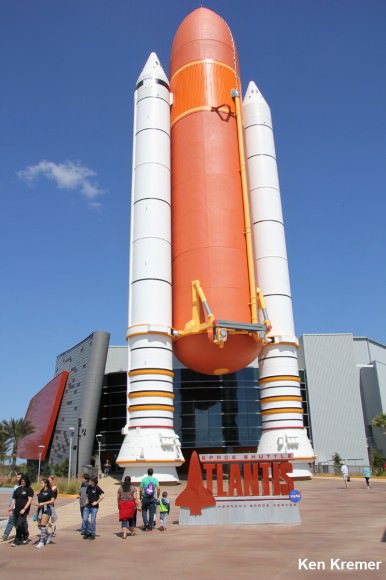
Why Trapping Somebody In Space Only Takes A Breeze (And Other Highlights From Expedition 40)
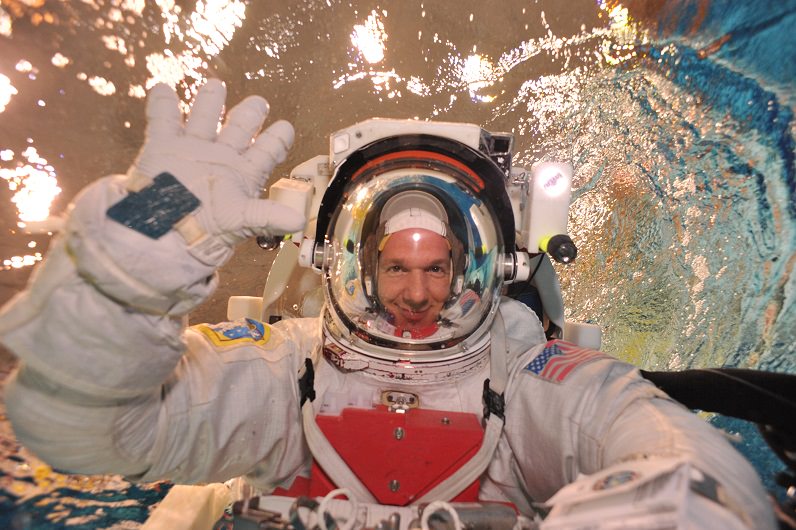
Imagine that you were in the middle of a module on the International Space Station. Floating in mid-air, far from handholds or any way to propel yourself. Is there any way to get out of that situation?
The short answer is not easily, and the longer answer is it could be an effective way to trap criminals in space, joked veteran cosmonaut Maxim Suraev in a press conference today (March 18) for the upcoming Expedition 40/41 mission, which also includes rookies Alex Gerst and Reid Wiseman.
Speaking in Russian, Suraev explained that during his last 2010 mission, he had crew members set him up in the middle of the station’s Node 3. “It is true that you can twist as much as a contortionist, but you won’t be able to move because you have nothing to bear against,” he said in remarks translated into English.
That said, the ventilation system on station does tend to push objects (and people) towards the vents after a time, he observed. What if you had multiple vents set up, however?
“I thought that if ever we have a permanent human habitation in space, this would be the best way to keep a person confined — like in a prison — in the middle of the room, where he or she could not move anywhere,” Suraev continued. “Being in limbo, as you will. The only thing that is required is a large room, a person and several fans blowing in different directions to keep the person in the middle of the room. That’s scary, trust me!”
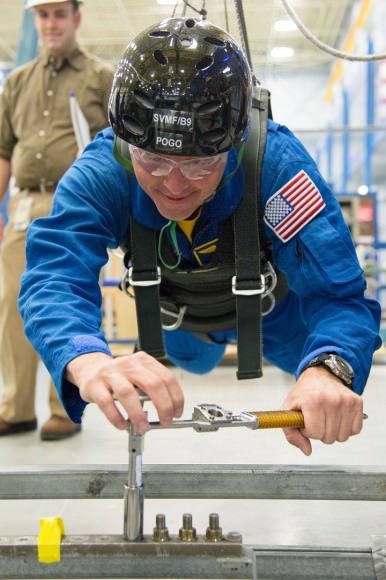
There’s no fear on Suraev’s part that it will happen with his crewmates, however. “My new crew, they’re really good guys and I’m really looking forward to being with my new crew in space, and to spend five and a half months aboard the space station,” he said in an English phone interview after the press conference. (Good news given that Suraev will assume command of Expedition 41.)
The crew (who lifts off in May) will have an action-packed mission. It will include the arrival of the last Automated Transfer Vehicle (ATV) and — if NASA fixes on a spacesuit leak allow — two American maintenance spacewalks. There also are 162 experiments to perform (this according to Gerst) and if there’s time, checking out our home planet.
“Earth observation was not one of the primary goals that [station] was designed for,” he cautioned in a phone interview, but he added that one of its strengths is there are people on board the orbiting laboratory that can fill in the gaps for other missions.
Gerst (who was a volcano researcher before becoming an astronaut) pointed out that if a volcano erupts, a typical Earth satellite would look straight down at it. Astronauts can swing around in the Cupola and get different views quickly, which could allow scientists to measure things such as the volcano plume height.
Another example of flexibility: The Expedition 39 crew right now is (news reports say) helping out with the search for the missing Malaysian Airline Flight 370.
“We’re really good at capturing things quickly and then sending the pictures down to the ground,” Gerst said.
Wiseman, as one of the rookies on mission, says he is interested in comparing the experience to his multi-month Navy missions at sea. It’s all a matter of mindset, he said in a phone interview. He once was assigned to a naval voyage that was expected to be at sea for six months. Then they were instructed it would be 10 months, leading to fistfights and other problems on board, he recalled.
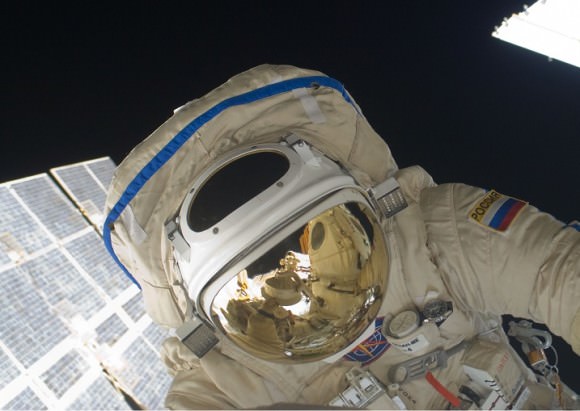
Astronauts for the forthcoming one-year mission to station, he pointed out, will launch with different expectations than someone expecting about a six-month stay. “If you know you’re up there for one year, you’re going to pace yourself for one year,” he said.
But there still will be sacrifices, as Wiseman has two daughters (five years old and eight years old). He’s asking the older child to do a bit of social media, and the younger one to draw pictures that could be included in the “care packages” astronauts receive from Earth. “It’s going to be tough not to see them on a daily basis. They grow so fast,” he said.
Other things to watch for on this mission include the arrival of the station’s first 3-D printer, setup of an alloy furnace to make new materials in microgravity, and a potential Wiseman-led “come out and wave campaign” that would encourage families to go outside and tweet about the space station as they watch it.
You can follow Expedition 40/41’s continuing adventures at Universe Today as well as on social media: @astro_reid for Wiseman, and for Gerst, @astro_alex or his Facebook page.
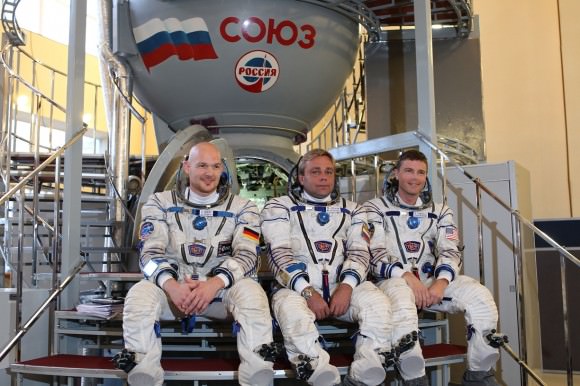
Exp40Selfie @astro_reid @astro_alex @NASAJSCStudents @nasa_astronauts @NASASocial @nasa_jsc pic.twitter.com/bX4ffSo4SX
— Stefan Medical TBlog (@StefanMed) March 18, 2014
Book Review and Giveaway: Max Goes To the Space Station – Children’s Books
Book review by David L. Hamilton
Jeffery Bennett’s Max Goes to the Space Station is the newest addition to the series A Science Adventure with Max the Dog. This series introduces children ages 4 to 12 to the exciting world of scientific thinking through adventurous story telling featuring a lovable and intelligent dog named Max. Max Goes to the Space Station also includes age appropriate suggested activities spanning grades 1 through 8.
This book uses words and illustrations to tell the exciting tale of Max the dog and his journey to the International Space Station, his adventures while on the station and his return home to his family. The main story is written so that younger children can follow along with Max and his adventures while also providing a “Big Kid Box” on each page for the older children. A “Big Kid Box” is a text box on each page that has more in-depth information for older children. At the back of the book are suggested activities for children in the first grade through the eighth grade. Max Goes to the Space Station is one of the many books included in the Stories from Space program. In this program, astronauts read a book from space while on the International Space Station. This year; 2014, astronauts are scheduled to read this book as well as other books from the series.
Universe Today and Big Kid Science are pleased to be able to offer two free copies of Max Goes to the Space Station to our readers. This contest is open to US and Canadian residents only. In order to be entered into the giveaway drawing, just put your email address into the box at the bottom of this post (where it says “Enter the Giveaway”) before Tuesday, March 24th. If this is the first time you’re registering for a giveaway, you’ll receive a confirmation email immediately where you’ll need to click a link to be entered into the drawing. For those who have registered previously, you’ll receive an email later where you can enter this drawing.
Max Goes to the Space Station and other books in this series are available on Amazon.com.
Max Goes to the Space Station A Science Adventure with Max the Dog [Hardcover] by Jeffery Bennett Illustrated. 32 Pages. Big Kid Science
About the author and illustrator:
Jeffrey Bennett is an astrophysicist and educator who proposed the idea for and helped develop the Voyage Scale Model Solar System—the first science-oriented exhibit approved for permanent installation on the National Mall in Washington, DC. In addition to writing the Science Adventures with Max the Dog series, he is the lead author of best selling college textbooks in astronomy, mathematics, statistics and astrobiology, as well as of critically acclaimed books for the general public. He lives with his family in Boulder, Colorado. Michael Carroll is a renowned space artist, a fellow of the International Association of Astronomical Artists, and a recipient of the Lucien Rudaux award for lifetime achievement in the astronomical arts. His work has been featured at NASA’s Jet Propulsion Laboratory and the National Air and Space Museum; in National Geographic, Smithsonian and Time; and on NOVA. He is also the illustrator of Max Goes to Jupiter. He lives in Littleton, Colorado.
About the reviewer:
David and his wife live in Conway, Arkansas. They are amateur astronomers that love spending nights stargazing and their days working in Higher Education. David graduated from the University of Arkansas at Little Rock with a Master of Education degree.

